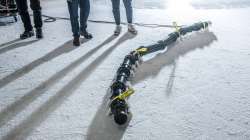NASA unveils snake-like robot to search for life on one of Saturn's Moons
NASA's Jet Propulsion Laboratory: Exobiology Extant Life Surveyor (EELS), a snake-like robot designed to explore Enceladus, one of Saturn's moons. To learn more about this remarkable bot, continue reading.

NASA's Jet Propulsion Laboratory (JPL) has revealed a snake-like robot that it intends to deploy to Enceladus, one of Saturn's moons, in search of life. The self-propelled robot, known as EELS (Exobiology Extant Life Surveyor), can travel over a range of surfaces on Earth, the Moon, and "far beyond," as per JPL, which claims that EELs was motivated by a desire to search for indications of life on Saturn's moon, Enceladus. If EELS succeeds in its mission, it might be a major advancement for humanity.
Geysers in Enceladus are expected to directly connect the ocean within to the surface, allowing a robot with sufficient endurance to travel across the limitless sea. Matthew Robinson of JPL said, "It has the capability to go to locations where other robots can't go. Though some robots are better at one particular type of terrain or other, the idea for EELS is the ability to do it all," he added further "When you're going places where you don't know what you'll find, you want to send a versatile, risk-aware robot that's prepared for uncertainty – and can make decisions on its own."
The robot is approximately 5 meters long and weighs roughly 100 kilograms. A unique device at the front may capture the environment in 3D and send videos to Earth. The rest of the body can help with measurements such as pressure, electrical conductivity, and temperature of the soils and subsoils that have been accessed. The 10 spinnings, identical segments that makeup EELS 1.0, use various screw threads for traction, propulsion, and grip.
The robot should be functional by the end of 2024. In addition to the seven to twelve years it will take to get to Saturn, EELS will likely have to wait for a long until a mission carrying it is launched. NASA does not have any plans to visit Enceladus in the next ten years.
